Story by Amarachi Orie • CNN
For 42-year-old Ghanaian Canadian artist Ekow Nimako, Lego is more than just a kids’ toy. A trickster deity in the form of a spider, a flower girl holding a giant bee and a Ghanaian kingdom in the year 3020 are all sculptures that he has built using only black Legos.
“I’m making art,” said Nimako. “This is fine art. It’s not a hobby, it’s not a toy, it’s not part of the Lego fandom, it’s not goofy. It doesn’t fall into a lot of categories that Lego creations fall into.”
He started making Lego sculptures in 2012 and his career took off two years later when he received a grant to exhibit his work in Canada during Black History Month. “I started realizing that not only did I enjoy making art with Lego, but it was important that I made Black art very specifically,” he said.
Nimako uses black Lego bricks specifically for three main reasons. The first is technical; black is one of the most common Lego colors, so there are many different pieces available for him to use.
The second is that he simply likes the color. “I think there’s something that is so sophisticated, something that is just expansive about black, and then there’s also something that is dark and sometimes foreboding or haunting about black. It has so much spectrum to it,” he explained.
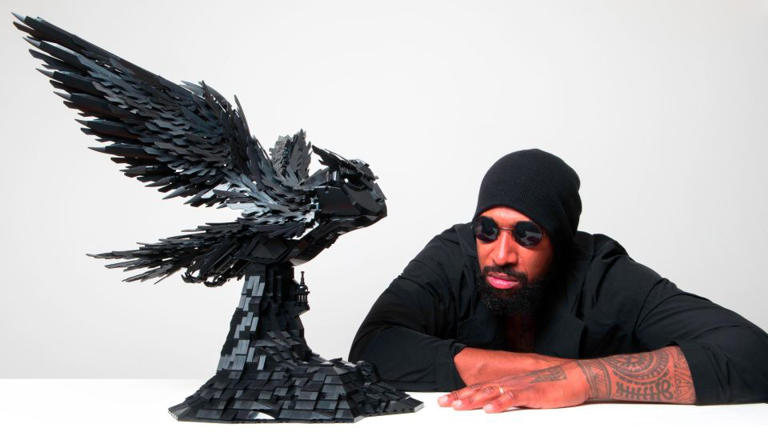
Nimako, pictured here next to his "Warrior Owl" sculpture, only uses black-colored Lego pieces. -
However, the most important reason is that the beings that he creates are “unequivocally Black. Despite their features or what I may do with them, they’ll always be regarded as Black,” he said.
The building blocks of life
In 2014, Nimako made his first human sculpture, “Flower Girl,” which “spoke to the innocence lost of young Black girls that didn’t get a chance to be like traditional flower girls in the West – speaking to the girls that came here as a result of the transatlantic slave trade,” he said.
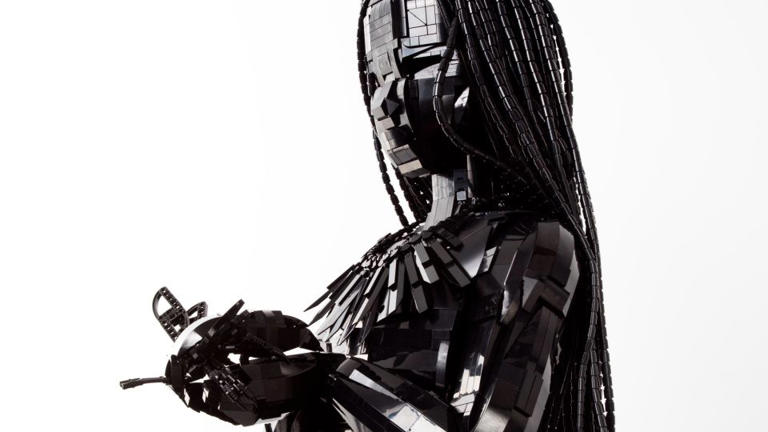
"Flower Girl" was the first human sculpture that Nimako made
The sculpture was initially the size of a six-year-old girl but as his technique developed and more Lego pieces were released, he aged her and enhanced her aesthetic. She is now the size of an average 10-year-old.
“There’s an intrinsic essence of life in my work,” said Nimako. “The sculptures are inanimate objects made of plastic. There’s something that’s quite synthetic about them. But it’s that synthetic quality that I strive to transcend with life, (such as by) spending a lot of time developing the eyes of each sculpture.”
It takes between 50 to 800 hours to make each sculpture, according to the Lego artist, who is “never in a rush.” For a sculpture that he is currently working on, he spent two hours building one section of a jaw, trying to find the right angles and the right parts, and “still didn’t finish.”
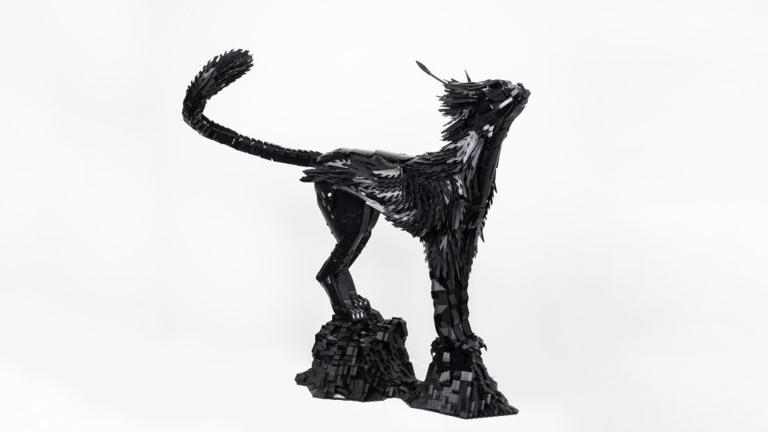
Named "Kadeesa" by his wife, this cat sculpture draws on the griffin, a mythological creature that is both lion and eagle, creating what Nimako calls a "griffyx."
He expects that the building process could become longer with each artwork as he discovers more Lego pieces and tries new techniques to make his artworks more dynamic.
“It’s a constant process of evolution,” he said.
‘Resistance is rooted in imagination’
Nimako considers himself to be a “futurist” who blends Africanfuturism, Afrofuturism and Afrofantasy. While Africanfuturism focuses on the experience of those on the African continent, Afrofuturism is more focused on the African American experience of looking into the future, drawing from the past and connecting to the continent, according to the artist.
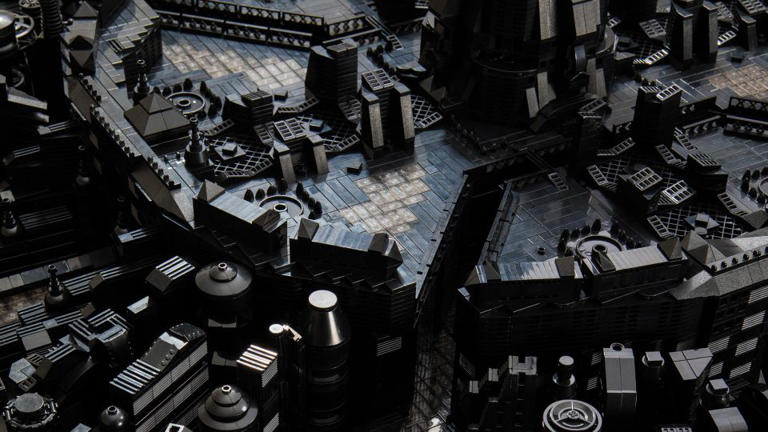
Nimako is a futurist who used approximately 100,000 Lego pieces to construct a reimagining of the medieval kingdom of Ghana, titled "Kumbi Saleh 3020 CE." -
In his “Building Black: Civilizations” series, Nimako reimagines medieval sub-Saharan African narratives. His “Kumbi Saleh 3020 CE” piece, which is made up of around 100,000 Lego bricks and can be found in the Aga Khan Museum in Toronto, is named after the capital city of a medieval Ghanaian kingdom. The artist explores medieval West Africa and reimagines what it would look like 1,000 years in the future.
Nimako hopes for an “inclusive future” that acknowledges the history of anti-Black racism and how “utterly disruptive” it is, and recognizes the role of Afrofuturism in allowing people to “envision a better world.”
“My wife always says, ‘all movements of resistance are rooted in that imagination.’ You have to imagine the freedom, the emancipation. You have to imagine this struggle being over. You have to project that in order to rise up, in order to resist. What else are you resisting for, if not for that Promised Land?” he said. “Even art is a form of resistance and it’s been used as a form of resistance for a very long time.”
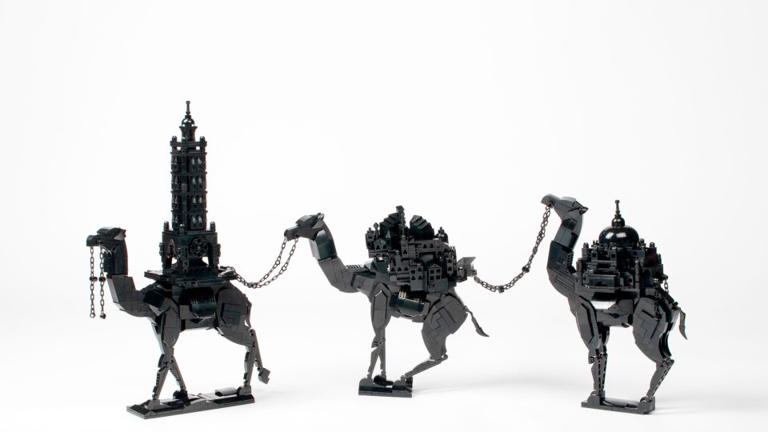
Each sculpture takes between 50 to 800 hours to create, and Nimako expects the building process to become longer as he tries new techniques to make his artworks more dynamic.
He recently released online kits for his “Building Beyond” workshop, which helps people to imagine and build representations of their own descendants from Lego using facial templates called “legacies.” He thinks that “it can help to foster sensitivity and understanding of complex cultures and ethnic groups.”
A Lego documentary
His work is being recognized beyond the art world – including by Lego itself. A Lego documentary based on his work was released in February 2022, and Nimako added that “the Lego Group has been really supportive of my work. After realizing what I do, there’s so much more that we’re going to be doing together.”
Nimako is currently building a sculpture called “The Great Turtle Race,” which depicts Black children racing on the backs of two mythological turtles to “capture the essence of childhood.”
“We’re Black artists when we’re making art,” he said. “You don’t get to just exist as an artist. There’s so much complexity and so much nuance and so much culture to explore. It fills me with so much joy … knowing that Black children are going to be able to engage with my work and see themselves reflected.”
A Lego documentary
His work is being recognized beyond the art world – including by Lego itself. A Lego documentary based on his work was released in February 2022, and Nimako added that “the Lego Group has been really supportive of my work. After realizing what I do, there’s so much more that we’re going to be doing together.”
Nimako is currently building a sculpture called “The Great Turtle Race,” which depicts Black children racing on the backs of two mythological turtles to “capture the essence of childhood.”
“We’re Black artists when we’re making art,” he said. “You don’t get to just exist as an artist. There’s so much complexity and so much nuance and so much culture to explore. It fills me with so much joy … knowing that Black children are going to be able to engage with my work and see themselves reflected.”
PHOTOS: Sam Engelking© Provided by CNN
No comments:
Post a Comment